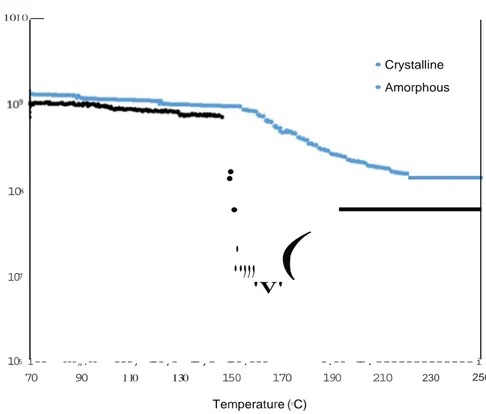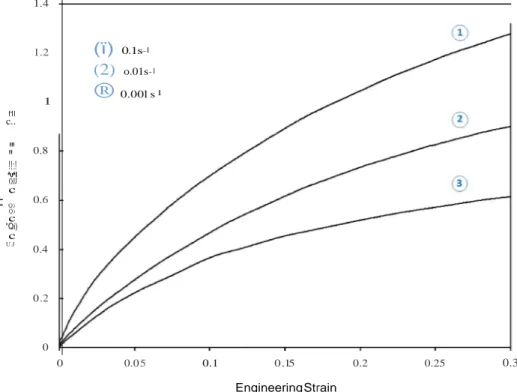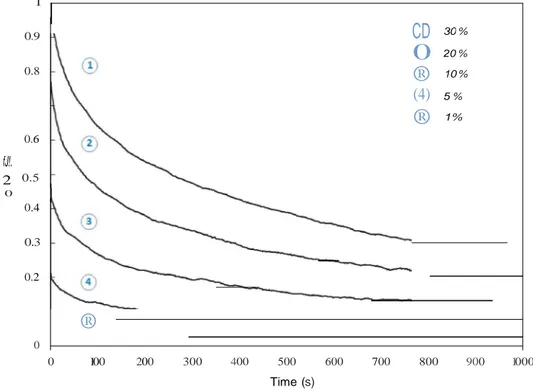HAL Id: hal-01515536
https://hal.archives-ouvertes.fr/hal-01515536
Submitted on 27 Apr 2017HAL is a multi-disciplinary open access archive for the deposit and dissemination of sci-entific research documents, whether they are pub-lished or not. The documents may come from teaching and research institutions in France or abroad, or from public or private research centers.
L’archive ouverte pluridisciplinaire HAL, est destinée au dépôt et à la diffusion de documents scientifiques de niveau recherche, publiés ou non, émanant des établissements d’enseignement et de recherche français ou étrangers, des laboratoires publics ou privés.
Mechanical behavior of amorphous PEEK in the
rubbery state
Lilian Martineau, France Chabert, Gérard Bernhart, Toufik Djilali
To cite this version:
Lilian Martineau, France Chabert, Gérard Bernhart, Toufik Djilali. Mechanical behavior of amorphous PEEK in the rubbery state. ECCM17 - 17th European Conference on Composite Materials, Jun 2016, Munich, Germany. 8 p. �hal-01515536�
This is an author-deposited version published in: http://oatao.univ-toulouse.fr/ Eprints ID: 17561
To cite this version:
Martineau, Lilian and Chabert, France and Bernhart, Gérard and Djilali,
Toufik Mechanical behavior of amorphous PEEK in the rubbery state. ( In
Press: 2016) In: ECCM17 - 17th European Conference on Composite
Materials, 26 June 2016 - 30 June 2016 (Munich, Germany)
O
pen
A
rchive
T
oulouse
A
rchive
O
uverte (
OATAO
)
OATAO is an open access repository that collects the work of Toulouse researchers and makes it freely available over the web where possible.
Any correspondence concerning this service should be sent to the repository administrator: staff-oatao@listes-diff.inp-toulouse.fr
,
MECHANICAL BEHAVIOR OF AMORPHOUS PEEK IN THE
RUBBERY STATE
L. Martineau 1 F. Chabert2 , G. Bernhart1 and T. Djilali3
1
Université de Toulouse ; CNRS, Mines Albi, INSA, UPS, ISAE-SUPAERO ; ICA (Institut Clément Ader) ; Campus Jarlard, F-81013 Albi, France
lilian.martineau@mines-albi.fr , gerard.bernhart@mines-albi.fr 2
Université de Toulouse, LGP-ENIT-INPT, F-65016 Tarbes, France france.chabert@enit.fr
3NIMITECH Innovation, F-65200 Bagnères de Bigorre, France toufik.djilali@nimitech.fr
Keywords: PEEK., amorphous state, mechanical behavior
Abstract
The mechanical behavior of amorphous poly(etheretherketone) (PEEK) was investigated just above the glass-transition temperature (Tg). In the rubbery state, the mobility of the macromolecular chains reveals a drop of mechanical properties with the onset of cold-crystallization as limit, as shown by dynamic-mechanical and thermal analysis. For an isothermal at 155°C, the onset of cold- crystallization begins after 40 minutes, this delay is long enough to perform static mechanical analysis. Thus, the understanding of the mechanical behavior was thoroughly investigated. From this study, di:fferent contributions are highlighted in the rubbery state: viscous and elastoplastic.
1. Introduction
Mastering the processing and the properties of PEEK is the foremost challenge in achieving the advances promised by thermoplastic composites. For about twenty years, carbon fiber reinforced PEEK offers a high potential for manufacturing high performance light weight structures for aerospace or other demanding applications [1]. In such fields, when high mechanical strength combined to resistance to temperature changes as well as resistance to chemicals are required, only high performance polymers can be used. In some cases, these kinds of polymers gradually replace metallic alloys with the advantages to be lighter and resistant to corrosion. Among them, the polyaryletherketone (PAEK) family has demonstrated to be the most resistant to thermo-oxidative degradation [2]. Nevertheless, due to high temperature processing and issues for controlling the crystallinity, forming PAEK based composites is still a challenge. In industry, the stamping process, widely used for manufacturing throughputs, induces often high cooling rates leading to degrees of crystallinity below the maximum attainable. It is well known that the mechanical behavior is influenced by the degree of crystallinity [3]. Indeed, the crystalline phase, where the macromolecules are closely packed to each others, strengthen the amorphous phase [4]. As a consequence, a polymer with a higher crystalline degree has a higher elastic modulus in the glassy state. This variation is even more striking above the glass transition temperature (Tg). The behavior of the PEEK matrix in the rubbery state has not been extensively studied until now. However, a deeper knowledge of the mechanical properties of PEEK in the rubbery state would lead to a better prediction of the behavior of parts under working conditions. In some cases such as machining of PEEK composites or high frequency fatigue loadings, the temperature of the material may locally exceed its glass transition. So, it is of great importance to well determine the behavior of PEEK for various degrees of crystallinity. The aim of the study hereby is to define the mechanical behavior of PEEK in the rubbery state, at an as low as possible degree of crystallinity close to the amorphous PEEK ones.
•
.
)
2. Material and experimental
Thick amorphous PEEK films (250 µ m) were purchased. Films were characterized in the as received condition and after 24h drying.
Amorphization level was checked by wide angle X-ray scattering, using a Philips PW 1700 in reflection mode with CuK.. radiation. The crystalline degree was calculated by integrating the area of the narrow peaks on the halo region of the amorphous phase.
Isothermal crystallization was carried out by using a Netzsch DSC 200 F3 at 155, 156, 157, 158, 159 and 160°C. The isothermal point was reached with a heating rate of 10°C.min-1 The initial time of the analysis was taken right after the sample reaches the equilibrium at the crystallization temperature. For clearer results, the baseline was corrected as a straight line passing through the two limits of the exothermal peak obtained.
The dynamic-mechanical behavior of the samples was analysed using the DMTAV Rheometric Scientific in tension mode, at a frequency of lHz in the temperature range of 70 to 250°C. The heating rate was 3°C.min-1
Relaxation tests at 155°C were performed for ten different engineering strain levels (0.5, 1, 1.5, 2, 5, 10, 15, 20, 25 and 30). The strain level was reached at a strain rate of 0.01 s-1 and hold time was 1000 s. The same testing conditions were applied on two testing apparatus: an electromechanical tensile testing machine Bose ElectroForce, for the highest strain levels, and a DMTAV Rheometric Scientific in tension mode, for the lowest ones.
Mechanical stress-strain curves were obtained using an electromechanical tensile testing machine Bose ElectroForce for three constant crosshead speed of 0.02 mm/s (0.001 s-1 , 0.2 mm/s (0.01 s-1 and
) )
2mm/s (0.1 s-1 at 155°C. Stress was calculated based on the initial cross-sectional area of the film.
3. Results and discussion
Wide angle X-ray scatteriog was used to make sure the PEEK is in amorphous state. Incomparison to thermal analysis such as DSC (differential scanning calorimetry), this technique does not require any sample heating, and leads to a more accurate degree of crystallinity [5-7]. Figure 1 shows the comparison of the patterns obtained for the amorphous PEEK film and the serni-crystalline PEEK film after annealing at 250°C for 2h. For amorphous PEEK, the wide amorphous halo region is observed with a very small peak at 20=29°, whereas numerous narrow peaks are superimposed on the halo region for the annealed PEEK. The degree of crystallinity is estimated to be lower than 1% for the amorphous film and 36% for the semi-crystalline film.
5 10 15 20 25 30 35 40
Scattering angle 29 (degrees)
Figure 1. X-ray diffractometer scans for amorphous PEEK film and film re-crystallized at 250°C for 2h
Like for any polymeric material, the mechanical responses of PEEK in its amorphous and semi- crystalline state are different, as shown by Cebe at room temperature [8]. This difference is strikingly
for high temperatures, especially when the PEEK goes over its glass transition at l 50°C. Beyond Tg,
the difference between storage moduli of amorphous PEEK and crystallized PEEK reaches one to two decades as shown on Figure 2 where the storage moduli measured by dynamic mechanical analysis for a temperature scan from 70°C up to 250°C are plotted. The structural order in the crystallized material hinders the relaxation of its macromolecular chains. As a consequence, the storage modulus stays at about 1 GPa and it slightly decreases with Tg up to a plateau at 0.1 GPa in the rubbery state.
The effect of temperature on the modulus is even more pronounced for amorphous PEEK: from 1 GPa in the glassy state, its modulus decreases up to 6 MPa. Just above the Tg, the modulus of amorphous PEEK increases due to the onset of cold-crystallization. According to Blundell, given that we are above Tg, the cold-crystallization kinetics has an exponential evolution with temperature [6]. From 200°C, the storage modulus of amorphous PEEK reaches a plateau at 70 MPa.
J:•,,' , ,,, ---Crysta lline
.
i i.
'' '' ' -Amorphous : 1 '""r
. .
.
.
' '' ' ' '''' ;1 ' : : • lt ' \ :/
1l 11 1 I I,,,
\j \
.//./\.
_.,..."" ... _. " .\..._ _..' .._... -... ... ''·... ...-... ... ...70 90 110 130 150 170 190 210 230 250
Temperature (0C)
Figure 2. Storage modulus versus temperature for: amorphous PEEK film; crystallized PEEK film.
Frequency 1 Hz for 3 °C/min
In order to characterize the mechanical behavior of amorphous PEEK in the rubbery state, no
structural reorganization must occur during the analysis to ensure the reliability of the measurements .
The stability of the temperature during the test is the key parameter to control the crystallization
kinetics and thereby its initiation. Strain can also generate a crystalline arrangement but the levels of
strain applied here are not high enough to provoke it [9]. Therefore, a thermal analysis bas been set up in order to choose the temperature of the test. Figure 3 shows the exothermic peaks extracted from the
DSC scans for several amorphous samples. These peaks are representative of the cold-crystallization ,
for various isothermal temperature from 155°C to 160°C. As a result, a temperature of 155°C, where
the cold crystallization only initiates after 40 minutes, would appear to be suitable for carrying the
mechanical tests. 1010 --- -•Crystalline •Amorphous 108 ••
•
107:.,,, (
'V' 1051-- ---,,.-- ---, ---,- --,- ---.--- -.-- --. --- iQ)
·=
" 't
f1l E (i; ..c: 0 -a c Q) 3: 0 ; .;:.f1l:.:.: ::c 0 500 1000 1500 Time (s) 2000 2500 3000Figure 3.Isothermal thermograms for amorphous PEEK at different temperatures
Stress-strain behavior at 155°C is shown Figure 4. The strain rate has a strong effect on the mechanical behavior of amorphous PEEK in the rubbery state. With a mechano-optical study, Daver explains this relation of dependence by a significant reduction in chain relaxation for high strain rates, thus leading
to an increase of modulus [9]. This behavior is representative of a viscous character.
1.4 1.2 f1l c.. "' .!.!.:.! Vl OJJ c Q) Q) c "Qi) c U.J 1 0.8 0.6 0.4 0.2 0 0 0.05 0.1 0.15 0.2 0.25 0.3 Engineering Strain
Figure 4. cr versus E curve for different strain rates (ï) 0.1s-1 (2) o.01s-1
®
0.00l s 1 (ï)0
®
C3) T = l60°C T = l59°C®
T= 158 °C T = 251 •c T = 156 °C @ T = 155 °CStress relaxation tests were undertaken in order to differentiate the viscous contribution from the elastic and/or plastic contribution. The method applied hereby has been used by Kichenin to simulate a two dissipative mechanisms model for polyethylene [1O]. The principle is to define, from results of relaxation tests, the stress-strain curve at "zero strain-rate", and thus to remove the viscous contribution. Indeed, the stress response for relaxed chains does not take into account this contribution.
Two experimental devices were used depending on the strain levels Eimp : a rheometer for the smallest
strains and a tensile testing machine for the largest strains. For each test, the strain was held constant until the stabilization of the stress is observed. As expected, all curves show the same general behavior
in Figure 5 and the relaxation takes longer when the initial strain is higher. The value of the stress after
stabilization, O"Jim, was noted.
1 0.9 0.8 fJ!. 0.6 2 0.5 0 0.4 0.3 0.2 0 0 100 200 300 400 500 600 Time (s) 700 800 900 1000
Figure 5.Stress relaxation for various levels of initial deformation
The stress-strain curve at "zero strain-rate" is generated by plotting cr1im versus Eimp [12]. This curve,
plotted in Figure 6, is divided into two linear parts with different slopes. This is an indication of an elastoplastic behavior. The initial slope corresponds to the elastic part and the second slope corresponds to the kinematic hardening assumed as linear.
CD
0
®
(4)®
30 % 20 % 10 % 5 % 1 %®
3 5
,...
,-
·
·
·
·
·
!
2---
-
-
---
!
5.... ...
...-
l
..
l
---
-
--
-.1--
--
1
-
---
---
----
---
-r
·
·
·
·
5 '.
b/
0 -.-- -r-- ---..,,-- ---.- -.- -.-- ---1 0. 0.2 ol1..l ;:;? .§ 0 0. 0.1 0 0.0 0 0.05 0.1 0.15 0.2 0.25 0.3 0.35Figure 6. O"Jim versus Eimp curve ("zero strain-rate" curve)
4. Conclusion
Semi-crystalline and amorphous PEEK show a very different behavior just above glass transition
temperature. In particular, the dynamic-mechanical analysis shows that the storage modulus of the
second one is more than one order of magnitude lower than first one. Moreover, this behavior happens
only in a very narrow temperature range and vanishes with time due to cold recrystallization. The
mechanical behavior was investigated by tensile and relaxation tests at 155°C to ensure that no
structural reorganization occurs during the experiments. A viscous behavior emerges from the tensile
tests at high strains. This viscous contribution prevents the readability of the other behaviors such as elastic and/or plastic. A stress-strain curve at "zero strain-rate" has been generated from the relaxation
tests at low strains. Thus, the viscous contribution is concealed and the others are highlighted. This
stress-strain curve indicates an elastoplastic behavior at "zerostrain-rate".
5. References
[1] P. D. Mangalgiri. Bulletion of materials science, 22(3):657-664
[2] J.Tarrieu. Study and durability of polymer packaging solutions of diamond chips for high
temperature power electronics. Ph.D. thesis, Institut National Polytechnique de Toulouse, 2012.
(in French)
[3] N. L. Batista, P. Olivier, G. Bernhart, M. C. Rezende, E. C. Botelho. Correlation between degree
of crystallinity, morphology and mechanical properties of PPS/carbon fiber laminates. Mat. Res.
[online]. 2016, vol.19 , n.1, pp.195-201
[4] R. K. Krishnaswamy and D. S. Kalika. Dynamic Mechanical Relaxation Properties of Poly (ether
Ether Ketone). Polymer, 35(6):1157-65, 1993.
[5] H. Gupta and R. Salovey. Thermal Behavior of Transparent Poly(etheretherketone)(PEEK) Film.
[6] D. J. Blundell and B. N. Osborn. The Morphology of Poly(aryl-Ether-Ether-Ketone). Polymer, 24(8):953-58, 1983.
[7] P. Cebe and S. Hong. Crystallization Behaviour of Poly(ether- ether-ketone). Polymer, 27(August): 1183-92, 1986.
[8] P. Cebe, S. Chung, and S. Hong. Effect of Thermal History on Mechanical Properties of Polyetheretherketone below the Glass Transition Temperature. Journal of Applied Polymer
Science, 33:487-503, 1987.
[9] F. Daver, A. Blake and M. Cakmak. Stages of Structural Ordering Leading to Stress
lnduced Crystallization of PEEK Films: A Mechano-Optical Study on Deformation, Relaxation and Retraction. Macromolecules, 42(7):2626-33, 2009.
[10] J. Kinchenin, K. Dang Van, and K. Boytard. Finite-Element Simulation of a New
Two-Dissipative Mechanisms Mode!for Bulk Medium-Density Polyethylene."Journal of




